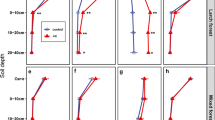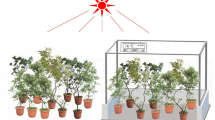Abstract
The nutrient concentrations and contents of needles and shoots of 22-year-old European larch (Larix decidua Mill.) were evaluated with respect to crown position, age of tissues and sampling date during a complete growing season. Concentrations of N, P, K, Ca, Mg and Zn in the needles and of N, P and K in the shoots differed significantly among the dates of sampling. The concentrations of N and Mn in the needles and all nutrients in the shoots (except Mg) also differed significantly with crown position. Maximum needle biomass was observed in the middle crown position (55% of the total) and maximum shoot biomass, in the lower crown position (52% of the total). Maximum needle and shoot nutrient contents were observed in the middle position of the living crown for long shoot, short shoot-1, short shoot-2, short shoot-3 and, short shoot-4 age classes while highest contents for short shoot-5 and short shoot-6 age classes were observed in the lower crown position. Biases up to 42% for Mg in the needles and 200% for K in the shoots were obtained when only long shoot tissues are used for content evaluation. For needles and shoots, Mg and K are more difficult nutrients to evaluate. A sampling methodology is proposed for evaluating nutrient contents of the living crown.
Similar content being viewed by others

References
Baldwin HI (1955) Course of seasonal height growth in European larch. Fox Forest Notes, No 60
Behan MJ (1968) Visual diagnosis of mineral deficiency in western larch. Mont For Conserv Exp St Bull 34: 7
Bernier B (1984) Nutrient cycling in Populus: a literature review with implications in intensively-managed plantations. Biomass Growth and Production. Enfor, Group B, Report No 6
Bonneau M (1988) Le diagnostic foliaire. Rev For Fr 40: 19–28
Bonneau M, Duchaufour P (1961) Quelques aperçus sur la nutrition minérale des résineux. Proceedings 13 th IUFRO Congress. September 1961: 21-3/1
Bonnet-Masimbert M (1982) Effect of growth regulators, girdling, and mulching on flowering of young European and Japanese larches under field conditions. Can J For Res 12: 270–279
Bouma D (1983) Diagnosis of mineral deficiencies using plant tests. In: Läuchli A, Bieleski RL (eds) Inorganic plant nutrition. Encyclopedia of plant physiology, new series, vol 15A. Springer, Berlin Heidelberg New York, pp 120–146
Bowen GD (1984) Coping with low nutrients. In: Bowen GD, Nambiar EKS (eds) Nutrition of plantation forests. Academic Press, London, pp 33–64
Canadian Soil Survey Committee (1987) The Canadian system of soil classification (2nd edn). Publ 1646E, Agric Canada, Ottawa
Carlyle JC, Malcolm DC (1986) Larch litter and nitrogen availability in mixed larch-spruce stands. I. Nutrient withdrawal, redistribution, and leaching loss from larch foliage at senescence. Can J For Res 16: 321–326
Chapin FS III, Kedrowski RA (1983) Seasonal changes in nitrogen and phosphorus fractions and autumn retranslocation in evergreen and deciduous taiga trees. Ecology 64: 376–391
Clausen JJ, Kozlowski TT (1967) Seasonal growth characteristics of long and short shoots of tamarack. Can J Bot 45: 1643–1651
Clausen JJ, Kozlowski TT (1970) Observations on growth of long shoots inLarix lancina. Can J Bot 48: 1045–1048
Czerney P, Fielder HJ (1968) Zur mineralstoffdynamik in den assimilationaorganen gedüngter und ungedüngter Baumarten auf einem Pseudogley-Standort. Arch Forstwes 17: 1263–1278
Everard J (1973) Foliar analysis sampling methods interpretation and application of the results. Q J For 67: 51–66
Fromm J, Essiamah S, Eschrich W (1987) Displacement of frequently occurring heavy metals in autumn leaves of beech (Fagus sylvatica). Trees 1: 164–171
Fujimoto S (1978) Studies on the shoot formation inLarix leptolepis Gordon. Res Bull Coll Exp For Hokkaido Univ 35: 1–28
Gower ST (1987) A comparison of aboveground productivity and carbon and nutrient allocation patterns of a deciduous (Larix occidentalis) and an evergreen. PhD thesis, University of Washington, Seattle
Gower ST, Grier CC, Vogt KA (1989) Aboveground production and N and P use byLarix occidentalis andPinus conforta in the Washington Cascades, USA. Tree Physiol 5: 1–11
Gower ST, Richards JH (1990) Larches: deciduous conifers in an evergreen world. B40: 818–826
Gower ST, Reich PB, Son Y (1993) Canopy dynamics and aboveground production of five tree species with different leaf longevities. Tree Physiol 12: 327–345
Helmisaari H-S (1990) Temporal variation in nutrient concentrations ofPinus sylvestris needles. Scand J For Res 5: 177–193
Hoehne H (1976) Blattanalytische Untersuchungen an jüngeren Lärchenbeständen (Larix decidua Mill.). Beitr Forstwirtsch 3: 138–147
Leyton L (1956) The relation between the growth and mineral composition of the foliage of Japanese larch (Larix leptolepis Murr.). Plant Soil 7: 167–177
Leyton L (1957) The relationship between the growth and mineral composition of the foliage of Japanese larch. II. Evidence from manurial trials. Plant Soil 9: 31–48
Materna J (1972) Information on larch nutrition (in Hungarian). Pr Vyzk Ustavu Lesn Hospod Myslivosti (Strnady) 42: 73–86
Matyssek R (1985) Der Kohlenstoff-, Wasser-und Nährstoff-hausshalt der wechselgrünen und immergrünen Koniferen, Lärche, Fichte, Kiefer. Doctoral thesis, University of Bayreuth, Germany
Matyssek R, Schulze E-D (1987) Heterosis in hybrid larch (Larix decidua x leptolepis). I. The role of leaf characteristics. Trees 1: 219–224
Matyssek R, Schulze E-D (1988) Carbon uptake and respiration in above-ground parts of a Larix decidua x leptolepis tree. Trees 2: 233–241
Mugasha AG, Pluth DJ, Hillman GR (1993) Foliar responses of tamarack and black spruce to drainage and fertilization of a minerotrophic peat land. Can J For Res 23: 166–180
Mutoh N (1972) Further studies on the phosphorus economy of the larch tree seedling by use of32P Jpn J Bot 20: 339–367
Myre R, Camiré C (1994) The establishment of stem nutrient distribution zones of European larch and tamarack using principal component analysis. Trees 9: 26–34
Owens JN, Molder M (1979) Bud development inLarix occidentalis. I. Growth and development of vegetative long shoot and vegetative short shoot buds. Can J Bot 57: 687–700
Parkinson JA, Allen SE (1975) A wet oxidation procedure suitable for the determination of nitrogen and mineral nutrients in biological material. Commun Soil Sci Plant Anal 6:1–11
Phu TD (1975) Nutrients requirements of planted European larch in Quebec. Plant Soil 42: 109–117
Powell GR (1988) Shoot elongation, leaf demography and bud formation in relation to branch position on Larix laricirw saplings. Trees 2: 150–164
Remphrey WR, Powell GR (1984a) Crown architecture of Larix laricina saplings: shoot preformation and neoformation and their relationships to shoot vigor. Can J Bot 62: 2181–2192
Remphrey WR, Powell GR (1984b) Crown architecture of Larix laricina saplings: quantitative analysis and modeling of (nonsylleptic) order 1 branching in relation to development of the main stem. Can J Bot 62: 1904–1915
Remphrey WR, Powell GR (1987) Crown architecture of Larix laricina saplings: an analysis of higher order branching. Can J Bot 65: 268–279
SAS (1985) SAS user's guide: statistics. SAS Institute, Cary, NC
Schueller J (1978) Évolution de la teneur en éléments minéraux des microphylles du mélèze (Larix decidua Mill.) dans les Alpes internes. Rev For Fr 30: 115–123
Son Y, Gower ST (1991) Aboveground nitrogen and phosphorus use by five plantation-grown trees with different leaf longevities. Biogeochemistry 14: 167–191
Son Y, Gower ST (1992) Nitrogen and phosphorus distribution for five plantation species in southwestern Wisconsin. For Ecol Manage 53: 175–193
Statsny T (1971) The effect of environmental conditions in modifying the expression of the genetic basis of the growth ofLarix decidua (Slovakian). Lesn Stud Vyskum Ust Lesn Hosp 10: 29–56
Steel RGD, Torrie TH (1980) Principles and procedures of statistics, 2nd edn. McGraw-Hill, New York
Strong TF, Zavitkovski J (1978) Morphology of jack pine and tamarack in dense stands needles. USDA Forest Service Res. Report NC-153
Thérien G, Camiré C (1986) Use of taper curve solved by an algebraic method in silvicultural research. For Chron 62: 529–532
Tilton DL (1975) The growth and nutrition of tamarack [Larix laricina (Du Roi) K. Koch]. PhD Dissertation. University of Minnesota, St. Paul, Minn
Tilton DL (1977) Seasonal growth and foliar nutrients ofLarix laricina three wetland ecosystems. Can J Bot 65: 1291–1298
Tilton DL (1978) Comparative growth and foliar element concentration ofLarix laricina over a range of wetland types in Minnesota. J Ecol 66: 499–512
Titus JS, Kang SM (1982) Nitrogen metabolism, translocation, and recycling in apple trees. Hort Rev 4: 204–246
Tyrrell LE (1985)Larix laricina andPicea mariana in a Wisconsin bog: the effect of leaf life span on foliar nutrient patterns, nutrient conservation, and growth efficiency. Master thesis, Ohio State University, Ohio
Tyrrell LE, Boerner REJ (1987)Larix laricina andPicea mariana: relationships among leaf life-span, foliar nutrient patterns, nutrient conservation, and growth efficiency. Can J Bot 65: 1570–1577
Wold S (1974) Spline functions in data analysis. Technometrics 16: 1–11
Author information
Authors and Affiliations
Rights and permissions
About this article
Cite this article
Myre, R., Camiré, C. The effect of crown position and date of sampling on biomass, nutrient concentrations and contents of needles and shoots in European larch. Trees 10, 339–350 (1996). https://doi.org/10.1007/BF02340781
Accepted:
Issue Date:
DOI: https://doi.org/10.1007/BF02340781



